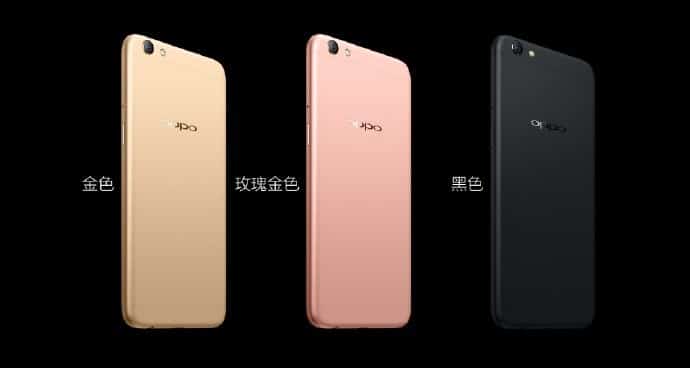News
OPPO R9s, R9s Plus with 16MP rear and front cameras break cover in China

Two new OPPO smartphones broke cover recently at a press event in China. The OPPO R9s and R9s Plus look particularly iPhone-ish, except the antenna lines on the metal-clad back of these devices are barely visible and their home button evokes Samsung’s aesthetics.
Oh, and they each have 16-megapixel rear- and front-facing cameras, which not only makes it infinitely easier for us to remember their camera specs, but also makes the phones an alluring pick for the selfie-loving generation. We were impressed with the 16-megapixel selfie cam on the F1 Plus, the R9s’ predecessor, and it would make sense to think OPPO has something similar, if not better, on offer here.
[irp posts=”2006″ name=”OPPO F1 Plus Hands-On Review”]
The rear-facing camera system, objectively speaking, is an even more impressive specimen, featuring a Sony sensor that no other device has yet and an f/1.7 aperture for superior performance in low light and to achieve a better depth of field, which some photographers refer to as “bokeh.” It can also shoot super-crisp 4K video at the standard 30 frames per second, though only the R9s Plus has an optically stabilized camera to compensate for shaky hands and movement.
The R9s comes with a 5.5-inch, 1080p screen with curved-but-not-too-curved Gorilla Glass 5; a Qualcomm Snapdragon 625 system-on-a-chip, alongside 4GB of RAM and 64GB of expandable storage; a fingerprint scanner on the home button; and a 3,010mAh battery that charges to 75 percent in 30 minutes.
The R9s Plus has a larger footprint, opting for a 6-inch display at full resolution and minimal bezels on the sides to keep the size of the phablet in check. Rounding off the specs, the Plus model makes use of a Snapdragon 653 chip, an incremental upgrade over the Snapdragon 652 inside many of today’s top midrange phones; 6GB of RAM; 64GB of storage; and a 4,000mAh battery.
[irp posts=”3906″ name=”The OPPO F1s is an affordable ‘selfie expert'”]
Both devices ship with Android 6.0 Marshmallow, making them the company’s first Marshmallow devices, although that isn’t meant to be a compliment. OPPO has been notoriously slow to adopt the latest Android software, with their existing phones still running Android Lollipop and below.
The OPPO R9s and R9s Plus will retail for 2,799 yuan ($415) and 3,499 yuan ($520) in their native China. They will go on sale starting October 28. The three available color options include gold, rose gold, and black. No word yet on pricing or an intended release outside China, but dollars to donuts, international markets will see the R9s under a different name before the year ends.
At least we hope so. These phones sound promising, and we’d hate to see them get a limited release.
Source: GSMArena

News
Xiaomi Redmi A3 Philippine pricing, availability
Budget smartphone with high refresh rate display

Xiaomi is bringing high refresh rate displays to its budget line with the announcement of the Redmi A3. The latest addition to the entry-level Redmi line boasts of an expansive 6.71-inch HD+ display with up to a 90Hz refresh rate.
The Redmi A3 is available in Midnight Black, Star Blue, and Forest Green. The smartphone is priced at PhP 3,399 (3GB+64GB) and PhP 3,999 (4GB+128GB) respectively for its two configurations.
Customers may preorder the phone until April 27 via Lazada, Shopee, and TikTok. General sale begins April 26th in all Xiaomi stores nationwide. Freebies are a Basic Piston Earphone for online purchases and a 3-month Viu Premium subscription for in-store purchases.
The Redmi A3’s immersive screen allows users to consume various content in high-definition with better smoothness, a boost for a phone of its price point. The screen has Corning Gorilla Glass 3 protection as well, and DC dimming to reduce blue light exposure.
The phone also sports a refined design that lets go of the iPhone-looking camera arrangement. Instead, the main camera is now in the middle as part of a watch face-looking setup similar to other Android phone offerings.
Speaking of, an 8MP main shooter highlights the back of the Redmi A3. In front is a 5MP front camera. The phone is powered by a MediaTek Helio G36 processor and runs on an Android 14-based OS. Furthermore, it has a 5,000mAh battery with 10W of USB-C charging.
Other handy Redmi A3 features for users to utilize include a 3.5mm jack, Face Unlock, and Fingerprint Unlock.
For the longest time, Google kept Pixel and Android behind two different teams. While the Pixel team dealt with devices made by and for the brand, the Android team ships a product meant for brands outside of the company’s purview. However, the days of separation are at an end. Google is officially merging its Pixel and Android teams together.
In a shocking announcement, the company has confirmed that the teams handling hardware and software will fall under a single team headed by Rick Osterloh. Prior to the merge, Osterloh was the senior vice president of devices and service, which was Google’s hardware branch. He will now oversee both hardware and software.
Because of the new leadership change, Hiroshi Lockheimer, former head of Android, will now move on to other projects within Alphabet. Of note, the change is not harsh for Lockheimer. He and Osterloh had been contemplating on the merge for a while.
Now, why the change? As is the case with everything today, it’s all because of AI. Speaking to The Verge, Osterloh explains that the merge will help with “full-stack innovation.” With how technology is these days, it’s now impossible to develop AI without having a close eye on hardware, such as in Google’s AI developments for the Pixel camera. Merging the teams will help streamline development, especially when hardware is involved.
Despite the change, outside brands, like Qualcomm’s Cristiano Amon, remains confident of Android’s capabilities outside of Google. Just expect more AI coming out in the near future.
Since the Pixel 6 series, Google continues to wow the market as one of the most unique camera designs available in the market today. This year, the brand’s Pixel 9 series might reinvent itself again with a slightly updated redesign.
Between the Pixel 6 and Pixel 8 series, Google introduced a wraparound camera island extending from the left edge to the right edge. While most smartphones today still use the traditional top-left island layout, Google’s lineup consistently grabs admiration from onlookers.
Now, according to an early leak (from Rozetked, via 9to5Google), Google might cut the camera island’s size before it reaches either side of the Pixel 9. The remaining chunk looks like a horizontal pill-shaped camera island right in the middle of the rear panel. It looks like a common camera island comically enlarged and turned on its side. Alternatively, it also looks like a webcam attached to a phone.
Based on the new leak, the new camera island will have three unknown lenses, the usual LED flash, and an unconfirmed sensor. Besides the different camera, the leak also confirms the usual tray of hardware on the side. There’s nothing too revolutionary.
As always, the Pixel 9 series is scheduled to come out in the fall of this year.
SEE ALSO: Pixel 9 series will reportedly come in four models
-

 Features1 week ago
Features1 week agoFortify your home office or business setup with these devices
-

 Events2 weeks ago
Events2 weeks agoStellar Blade: PlayStation taps cosplayers to play Eve for game’s launch
-

 Gaming2 weeks ago
Gaming2 weeks agoThe Rogue Prince of Persia looks like an ultra-colorful roguelite
-

 Accessories2 weeks ago
Accessories2 weeks agoLogitech unveils G Pro X 60 gaming keyboard: Price, details
-

 Gaming2 weeks ago
Gaming2 weeks agoStar Wars Outlaws release date revealed
-

 Reviews1 week ago
Reviews1 week agorealme 12+ 5G review: One month later
-

 Gaming2 weeks ago
Gaming2 weeks agoLenovo confirms development of a Legion Go 2
-

 Deals2 weeks ago
Deals2 weeks agoTCL P635 TV: Big savings for TCL’s anniversary


























